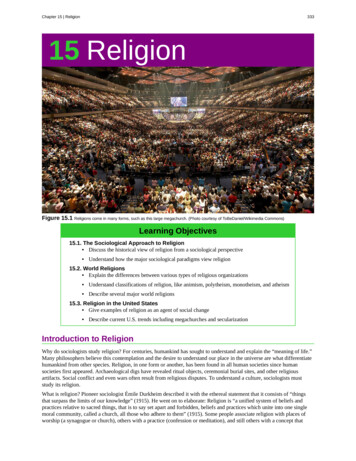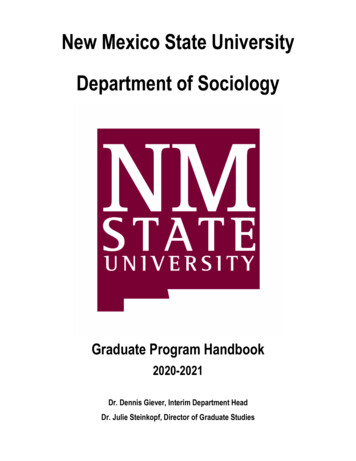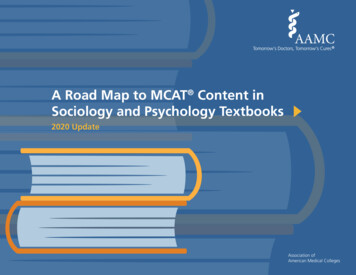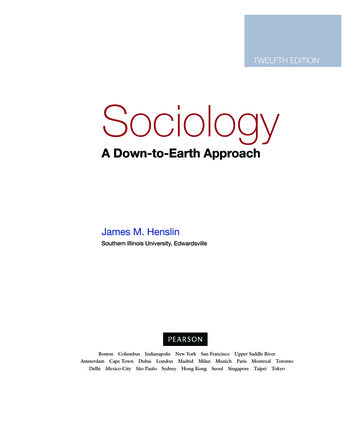
Transcription
Chapter 15 Religion33315 ReligionFigure 15.1 Religions come in many forms, such as this large megachurch. (Photo courtesy of ToBeDaniel/Wikimedia Commons)Learning Objectives15.1. The Sociological Approach to Religion Discuss the historical view of religion from a sociological perspective Understand how the major sociological paradigms view religion15.2. World Religions Explain the differences between various types of religious organizations Understand classifications of religion, like animism, polytheism, monotheism, and atheism Describe several major world religions15.3. Religion in the United States Give examples of religion as an agent of social change Describe current U.S. trends including megachurches and secularizationIntroduction to ReligionWhy do sociologists study religion? For centuries, humankind has sought to understand and explain the “meaning of life.”Many philosophers believe this contemplation and the desire to understand our place in the universe are what differentiatehumankind from other species. Religion, in one form or another, has been found in all human societies since humansocieties first appeared. Archaeological digs have revealed ritual objects, ceremonial burial sites, and other religiousartifacts. Social conflict and even wars often result from religious disputes. To understand a culture, sociologists muststudy its religion.What is religion? Pioneer sociologist Émile Durkheim described it with the ethereal statement that it consists of “thingsthat surpass the limits of our knowledge” (1915). He went on to elaborate: Religion is “a unified system of beliefs andpractices relative to sacred things, that is to say set apart and forbidden, beliefs and practices which unite into one singlemoral community, called a church, all those who adhere to them” (1915). Some people associate religion with places ofworship (a synagogue or church), others with a practice (confession or meditation), and still others with a concept that
334Chapter 15 Religionguides their daily lives (like dharma or sin). All these people can agree that religion is a system of beliefs, values, andpractices concerning what a person holds sacred or considers to be spiritually significant.Does religion bring fear, wonder, relief, explanation of the unknown or control over freedom and choice? How do ourreligious perspectives affect our behavior? These are questions sociologists ask and are reasons they study religion. Whatare peoples' conceptions of the profane and the sacred? How do religious ideas affect the real-world reactions and choicesof people in a society?Religion can also serve as a filter for examining other issues in society and other components of a culture. For example,after the terrorist attacks of September 11, 2001, it became important for teachers, church leaders, and the media to educateAmericans about Islam to prevent stereotyping and to promote religious tolerance. Sociological tools and methods, such assurveys, polls, interviews, and analysis of historical data, can be applied to the study of religion in a culture to help usbetter understand the role religion plays in people’s lives and the way it influences society.15.1 The Sociological Approach to ReligionFrom the Latin religio (respect for what is sacred) and religare (to bind, in the sense of an obligation), the term religiondescribes various systems of belief and practice that define what people consider to be sacred or spiritual (Fasching anddeChant 2001; Durkheim 1915). Throughout history, and in societies across the world, leaders have used religiousnarratives, symbols, and traditions in an attempt to give more meaning to life and understand the universe. Some form ofreligion is found in every known culture, and it is usually practiced in a public way by a group. The practice of religioncan include feasts and festivals, intercession with God or gods, marriage and funeral services, music and art, meditation orinitiation, sacrifice or service, and other aspects of culture.While some people think of religion as something individual because religious beliefs can be highly personal, religion isalso a social institution. Social scientists recognize that religion exists as an organized and integrated set of beliefs,behaviors, and norms centered on basic social needs and values. Moreover, religion is a cultural universal found in allsocial groups. For instance, in every culture, funeral rites are practiced in some way, although these customs vary betweencultures and within religious affiliations. Despite differences, there are common elements in a ceremony marking aperson’s death, such as announcement of the death, care of the deceased, disposition, and ceremony or ritual. Theseuniversals, and the differences in the way societies and individuals experience religion, provide rich material forsociological study.In studying religion, sociologists distinguish between what they term the experience, beliefs, and rituals of a religion.Religious experience refers to the conviction or sensation that we are connected to “the divine.” This type of communionmight be experienced when people are pray or meditate. Religious beliefs are specific ideas members of a particular faithhold to be true, such as that Jesus Christ was the son of God, or that reincarnation exists. Another illustration of religiousbeliefs is the creation stories we find in different religions. Religious rituals are behaviors or practices that are eitherrequired or expected of the members of a particular group, such as bar mitzvah or confession of sins (Barkan andGreenwood 2003).The History of Religion as a Sociological ConceptIn the wake of nineteenth century European industrialization and secularization, three social theorists attempted toexamine the relationship between religion and society: Émile Durkheim, Max Weber, and Karl Marx. They are among thefounding thinkers of modern sociology.As stated earlier, French sociologist Émile Durkheim (1858–1917) defined religion as a “unified system of beliefs andpractices relative to sacred things” (1915). To him, sacred meant extraordinary—something that inspired wonder and thatseemed connected to the concept of “the divine.” Durkheim argued that “religion happens” in society when there is aseparation between the profane (ordinary life) and the sacred (1915). A rock, for example, isn’t sacred or profane as itexists. But if someone makes it into a headstone, or another person uses it for landscaping, it takes on differentmeanings—one sacred, one profane.Durkheim is generally considered the first sociologist who analyzed religion in terms of its societal impact. Above all, hebelieved religion is about community: It binds people together (social cohesion), promotes behavior consistency (socialcontrol), and offers strength during life’s transitions and tragedies (meaning and purpose). By applying the methods ofnatural science to the study of society, Durkheim held that the source of religion and morality is the collective mind-set ofsociety and that the cohesive bonds of social order result from common values in a society. He contended that these valuesneed to be maintained to maintain social stability.This OpenStax book is available for free at http://cnx.org/content/col11762/1.6
Chapter 15 Religion335But what would happen if religion were to decline? This question led Durkheim to posit that religion is not just a socialcreation but something that represents the power of society: When people celebrate sacred things, they celebrate the powerof their society. By this reasoning, even if traditional religion disappeared, society wouldn’t necessarily dissolve.Whereas Durkheim saw religion as a source of social stability, German sociologist and political economist Max Weber(1864–1920) believed it was a precipitator of social change. He examined the effects of religion on economic activitiesand noticed that heavily Protestant societies—such as those in the Netherlands, England, Scotland, and Germany—werethe most highly developed capitalist societies and that their most successful business leaders were Protestant. In hiswriting The Protestant Ethic and the Spirit of Capitalism (1905), he contends that the Protestant work ethic influenced thedevelopment of capitalism. Weber noted that certain kinds of Protestantism supported the pursuit of material gain bymotivating believers to work hard, be successful, and not spend their profits on frivolous things. (The modern use of“work ethic” comes directly from Weber’s Protestant ethic, although it has now lost its religious connotations.)Making Connections:theBig PictureThe Protestant Work Ethic in the Information AgeMax Weber (1904) posited that, in Europe in his time, Protestants were more likely than Catholics to value capitalistideology, and believed in hard work and savings. He showed that Protestant values directly influenced the rise ofcapitalism and helped create the modern world order. Weber thought the emphasis on community in Catholicismversus the emphasis on individual achievement in Protestantism made a difference. His century-old claim that theProtestant work ethic led to the development of capitalism has been one of the most important and controversialtopics in the sociology of religion. In fact, scholars have found little merit to his contention when applied to modernsociety (Greeley 1989).What does the concept of work ethic mean today? The work ethic in the information age has been affected bytremendous cultural and social change, just as workers in the mid- to late nineteenth century were influenced by thewake of the Industrial Revolution. Factory jobs tend to be simple, uninvolved, and require very little thinking ordecision making on the part of the worker. Today, the work ethic of the modern workforce has been transformed, asmore thinking and decision making is required. Employees also seek autonomy and fulfillment in their jobs, not justwages. Higher levels of education have become necessary, as well as people management skills and access to themost recent information on any given topic. The information age has increased the rapid pace of production expectedin many jobs.On the other hand, the “McDonaldization” of the United States (Hightower 1975; Ritzer 1993), in which manyservice industries, such as the fast-food industry, have established routinized roles and tasks, has resulted in a“discouragement” of the work ethic. In jobs where roles and tasks are highly prescribed, workers have no opportunityto make decisions. They are considered replaceable commodities as opposed to valued employees. During times ofrecession, these service jobs may be the only employment possible for younger individuals or those with low-levelskills. The pay, working conditions, and robotic nature of the tasks dehumanizes the workers and strips them ofincentives for doing quality work.Working hard also doesn’t seem to have any relationship with Catholic or Protestant religious beliefs anymore, orthose of other religions; information age workers expect talent and hard work to be rewarded by material gain andcareer advancement.German philosopher, journalist, and revolutionary socialist Karl Marx (1818–1883) also studied the social impact ofreligion. He believed religion reflects the social stratification of society and that it maintains inequality and perpetuates thestatus quo. For him, religion was just an extension of working-class (proletariat) economic suffering. He famously arguedthat religion “is the opium of the people” (1844).For Durkheim, Weber, and Marx, who were reacting to the great social and economic upheaval of the late nineteenthcentury and early twentieth century in Europe, religion was an integral part of society. For Durkheim, religion was a forcefor cohesion that helped bind the members of society to the group, while Weber believed religion could be understood assomething separate from society. Marx considered religion inseparable from the economy and the worker. Religion couldnot be understood apart from the capitalist society that perpetuated inequality. Despite their different views, these socialtheorists all believed in the centrality of religion to society.
336Chapter 15 ReligionTheoretical Perspectives on ReligionFigure 15.2 Functionalists believe religion meets many important needs for people, including group cohesion and companionship. (Photocourtesy of James Emery/flickr)Modern-day sociologists often apply one of three major theoretical perspectives. These views offer different lensesthrough which to study and understand society: functionalism, symbolic interactionism, and conflict theory. Let’s explorehow scholars applying these paradigms understand religion.FunctionalismFunctionalists contend that religion serves several functions in society. Religion, in fact, depends on society for itsexistence, value, and significance, and vice versa. From this perspective, religion serves several purposes, like providinganswers to spiritual mysteries, offering emotional comfort, and creating a place for social interaction and social control.In providing answers, religion defines the spiritual world and spiritual forces, including divine beings. For example, ithelps answer questions like, “How was the world created?” “Why do we suffer?” “Is there a plan for our lives?” and “Isthere an afterlife?” As another function, religion provides emotional comfort in times of crisis. Religious rituals bringorder, comfort, and organization through shared familiar symbols and patterns of behavior.One of the most important functions of religion, from a functionalist perspective, is the opportunities it creates for socialinteraction and the formation of groups. It provides social support and social networking and offers a place to meet otherswho hold similar values and a place to seek help (spiritual and material) in times of need. Moreover, it can foster groupcohesion and integration. Because religion can be central to many people’s concept of themselves, sometimes there is an“in-group” versus “out-group” feeling toward other religions in our society or within a particular practice. On an extremelevel, the Inquisition, the Salem witch trials, and anti-Semitism are all examples of this dynamic. Finally, religionpromotes social control: It reinforces social norms such as appropriate styles of dress, following the law, and regulatingsexual behavior.Conflict TheoryConflict theorists view religion as an institution that helps maintain patterns of social inequality. For example, the Vaticanhas a tremendous amount of wealth, while the average income of Catholic parishioners is small. According to thisperspective, religion has been used to support the “divine right” of oppressive monarchs and to justify unequal socialstructures, like India’s caste system.Conflict theorists are critical of the way many religions promote the idea that believers should be satisfied with existingcircumstances because they are divinely ordained. This power dynamic has been used by Christian institutions forcenturies to keep poor people poor and to teach them that they shouldn’t be concerned with what they lack because their“true” reward (from a religious perspective) will come after death. Conflict theorists also point out that those in power in areligion are often able to dictate practices, rituals, and beliefs through their interpretation of religious texts or viaproclaimed direct communication from the divine.This OpenStax book is available for free at http://cnx.org/content/col11762/1.6
Chapter 15 Religion337Figure 15.3 Many religions, including the Catholic faith, have long prohibited women from becoming spiritual leaders. Feminist theorists focus ongender inequality and promote leadership roles for women in religion. (Photo courtesy of Wikimedia Commons)The feminist perspective is a conflict theory view that focuses specifically on gender inequality. In terms of religion,feminist theorists assert that, although women are typically the ones to socialize children into a religion, they havetraditionally held very few positions of power within religions. A few religions and religious denominations are moregender equal, but male dominance remains the norm of most.Making Connections:Sociologyin theReal WorldRational Choice Theory: Can Economic Theory BeApplied to Religion?How do people decide which religion to follow, if any? How does one pick a church or decide which denomination“fits” best? Rational choice theory (RCT) is one way social scientists have attempted to explain these behaviors. Thetheory proposes that people are self-interested, though not necessarily selfish, and that people make rationalchoices—choices that can reasonably be expected to maximize positive outcomes while minimizing negativeoutcomes. Sociologists Roger Finke and Rodney Stark (1988) first considered the use of RCT to explain someaspects of religious behavior, with the assumption that there is a basic human need for religion in terms of providingbelief in a supernatural being, a sense of meaning in life, and belief in life after death. Religious explanations of theseconcepts are presumed to be more satisfactory than scientific explanations, which may help to account for thecontinuation of strong religious connectedness in countries such as the United States, despite predictions of somecompeting theories for a great decline in religious affiliation due to modernization and religious pluralism.Another assumption of RCT is that religious organizations can be viewed in terms of “costs” and “rewards.” Costsare not only monetary requirements, but are also the time, effort, and commitment demands of any particular religiousorganization. Rewards are the intangible benefits in terms of belief and satisfactory explanations about life, death, andthe supernatural, as well as social rewards from membership. RCT proposes that, in a pluralistic society with manyreligious options, religious organizations will compete for members, and people will choose between differentchurches or denominations in much the same way they select other consumer goods, balancing costs and rewards in arational manner. In this framework, RCT also explains the development and decline of churches, denominations,sects, and even cults; this limited part of the very complex RCT theory is the only aspect well supported by researchdata.Critics of RCT argue that it doesn’t fit well with human spiritual needs, and many sociologists disagree that the costsand rewards of religion can even be meaningfully measured or that individuals use a rational balancing processregarding religious affiliation. The theory doesn’t address many aspects of religion that individuals may consideressential (such as faith) and further fails to account for agnostics and atheists who don’t seem to have a similar needfor religious explanations. Critics also believe this theory overuses economic terminology and structure and point outthat terms such as “rational” and “reward” are unacceptably defined by their use; they would argue that the theory isbased on faulty logic and lacks external, empirical support. A scientific explanation for why something occurs can’treasonably be supported by the fact that it does occur. RCT is widely used in economics and to a lesser extent incriminal justice, but the application of RCT in explaining the religious beliefs and behaviors of people and societies isstill being debated in sociology today.
338Chapter 15 ReligionSymbolic InteractionismRising from the concept that our world is socially constructed, symbolic interactionism studies the symbols andinteractions of everyday life. To interactionists, beliefs and experiences are not sacred unless individuals in a societyregard them as sacred. The Star of David in Judaism, the cross in Christianity, and the crescent and star in Islam areexamples of sacred symbols. Interactionists are interested in what these symbols communicate. Because interactionistsstudy one-on-one, everyday interactions between individuals, a scholar using this approach might ask questions focused onthis dynamic. The interaction between religious leaders and practitioners, the role of religion in the ordinary componentsof everyday life, and the ways people express religious values in social interactions—all might be topics of study to aninteractionist.15.2 World ReligionsFigure 15.4 The symbols of fourteen religions are depicted here. In no particular order, they represent Judaism, Wicca, Taoism, Christianity,Confucianism, Baha’i, Druidism, Islam, Hinduism, Zoroastrianism, Shinto, Jainism, Sikhism, and Buddhism. Can you match the symbol to the religion?What might a symbolic interactionist make of these symbols? (Photo courtesy of ReligiousTolerance.org (http://ReligiousTolerance.org) )The major religions of the world (Hinduism, Buddhism, Islam, Confucianism, Christianity, Taoism, and Judaism) differ inmany respects, including how each religion is organized and the belief system each upholds. Other differences include thenature of belief in a higher power, the history of how the world and the religion began, and the use of sacred texts andobjects.Types of Religious OrganizationsReligions organize themselves—their institutions, practitioners, and structures—in a variety of fashions. For instance,when the Roman Catholic Church emerged, it borrowed many of its organizational principles from the ancient Romanmilitary and turned senators into cardinals, for example. Sociologists use different terms, like ecclesia, denomination, andsect, to define these types of organizations. Scholars are also aware that these definitions are not static. Most religionstransition through different organizational phases. For example, Christianity began as a cult, transformed into a sect, andtoday exists as an ecclesia.Cults, like sects, are new religious groups. In the United States today this term often carries pejorative connotations.However, almost all religions began as cults and gradually progressed to levels of greater size and organization. The termcult is sometimes used interchangeably with the term new religious movement (NRM). In its pejorative use, these groupsare often disparaged as being secretive, highly controlling of members’ lives, and dominated by a single, charismaticleader.Controversy exists over whether some groups are cults, perhaps due in part to media sensationalism over groups likepolygamous Mormons or the Peoples Temple followers who died at Jonestown, Guyana. Some groups that arecontroversially labeled as cults today include the Church of Scientology and the Hare Krishna movement.A sect is a small and relatively new group. Most of the well-known Christian denominations in the United States todaybegan as sects. For example, the Methodists and Baptists protested against their parent Anglican Church in England, justas Henry VIII protested against the Catholic Church by forming the Anglican Church. From “protest” comes the termProtestant.This OpenStax book is available for free at http://cnx.org/content/col11762/1.6
Chapter 15 Religion339Occasionally, a sect is a breakaway group that may be in tension with larger society. They sometimes claim to be returningto “the fundamentals” or to contest the veracity of a particular doctrine. When membership in a sect increases over time, itmay grow into a denomination. Often a sect begins as an offshoot of a denomination, when a group of members believesthey should separate from the larger group.Some sects dissolve without growing into denominations. Sociologists call these established sects. Established sects, suchas the Amish or Jehovah’s Witnesses fall halfway between sect and denomination on the ecclesia–cult continuum becausethey have a mixture of sect-like and denomination-like characteristics.A denomination is a large, mainstream religious organization, but it does not claim to be official or state sponsored. It isone religion among many. For example, Baptist, African Methodist Episcopal, Catholic, and Seventh-day Adventist are allChristian denominations.The term ecclesia, originally referring to a political assembly of citizens in ancient Athens, Greece, now refers to acongregation. In sociology, the term is used to refer to a religious group that most all members of a society belong to. It isconsidered a nationally recognized, or official, religion that holds a religious monopoly and is closely allied with state andsecular powers. The United States does not have an ecclesia by this standard; in fact, this is the type of religiousorganization that many of the first colonists came to America to escape.Figure 15.5 How might you classify the Mennonites? As a cult, a sect, or a denomination? (Photo courtesy of Frenkieb/flickr)One way to remember these religious organizational terms is to think of cults, sects, denominations, and ecclesiarepresenting a continuum, with increasing influence on society, where cults are least influential and ecclesia are mostinfluential.Types of ReligionsScholars from a variety of disciplines have strived to classify religions. One widely accepted categorization that helpspeople understand different belief systems considers what or who people worship (if anything). Using this method ofclassification, religions might fall into one of these basic categories, as shown in Table 15.1.
340Chapter 15 ReligionTable 15.1 One way scholars have categorized religions is by classifying what or who they hold to bedivine.ReligiousClassificationWhat/Who Is DivineExamplePolytheismMultiple godsBelief systems of the ancient Greeks andRomansMonotheismSingle godJudaism, IslamAtheismNo deitiesAtheismAnimismNonhuman beings (animals, plants,natural world)Indigenous nature worship (Shinto)TotemismHuman-natural being connectionOjibwa (Native American) beliefsNote that some religions may be practiced—or understood—in various categories. For instance, the Christian notion of theHoly Trinity (God, Jesus, Holy Spirit) defies the definition of monotheism, which is a religion based on belief in a singledeity, to some scholars. Similarly, many Westerners view the multiple manifestations of Hinduism’s godhead aspolytheistic, which is a religion based on belief in multiple deities,, while Hindus might describe those manifestations area monotheistic parallel to the Christian Trinity. Some Japanese practice Shinto, which follows animism, which is areligion that believes in the divinity of nonhuman beings, like animals, plants, and objects of the natural world, whilepeople who practice totemism believe in a divine connection between humans and other natural beings.It is also important to note that every society also has nonbelievers, such as atheists, who do not believe in a divine beingor entity, and agnostics, who hold that ultimate reality (such as God) is unknowable. While typically not an organizedgroup, atheists and agnostics represent a significant portion of the population. It is important to recognize that being anonbeliever in a divine entity does not mean the individual subscribes to no morality. Indeed, many Nobel Peace Prizewinners and other great humanitarians over the centuries would have classified themselves as atheists or agnostics.The World’s ReligionsReligions have emerged and developed across the world. Some have been short-lived, while others have persisted andgrown. In this section, we will explore seven of the world’s major religions.HinduismThe oldest religion in the world, Hinduism originated in the Indus River Valley about 4,500 years ago in what is nowmodern-day northwest India and Pakistan. It arose contemporaneously with ancient Egyptian and Mesopotamian cultures.With roughly one billion followers, Hinduism is the third-largest of the world’s religions. Hindus believe in a divine powerthat can manifest as different entities. Three main incarnations—Brahma, Vishnu, and Shiva—are sometimes compared tothe manifestations of the divine in the Christian Trinity.Multiple sacred texts, collectively called the Vedas, contain hymns and rituals from ancient India and are mostly written inSanskrit. Hindus generally believe in a set of principles called dharma, which refer to one’s duty in the world thatcorresponds with “right” actions. Hindus also believe in karma, or the notion that spiritual ramifications of one’s actionsare balanced cyclically in this life or a future life (reincarnation).Figure 15.6 Hindu women sometimes apply decorations of henna dye to their hands for special occasions such as weddings and religiousfestivals. (Photo courtesy of Akash Mazumdar)This OpenStax book is available for free at http://cnx.org/content/col11762/1.6
Chapter 15 Religion341Figure 15.7 Buddhism promotes peace and tolerance. The 14th Dalai Lama (Tenzin Gyatso) is one of the most revered and influential TibetanBuddhist leaders. (Photo courtesy of Nancy Pelosi/flickr)BuddhismBuddhism was founded by Siddhartha Gautama around 500 B.C.E. Siddhartha was said to have given up a comfortable,upper-class life to follow one of poverty and spiritual devotion. At the age of thirty-five, he famously meditated under asacred fig tree and vowed not to rise before he achieved enlightenment (bodhi). After this experience, he became known asBuddha, or “enlightened one.” Followers were drawn to Buddha’s teachings and the practice of meditation, and he laterestablished a monastic order.Figure 15.8 Meditation is an important practice in Buddhism. A Tibetan monk is shown here engaged in solitary meditation. (Photo courtesy ofPrince Roy/flickr)Buddha’s teachings encourage Buddhists to lead a moral life by accepting the four Noble Truths: 1) life is suffering, 2)suffering arises from attachment to desires, 3) suffering ceases when attachment to desires ceases, and 4) freedom fromsuffering is possible by following the “middle way.” The concept of the “middle way” is central to Buddhist thinking,which encourages people to live in t
To him, sacred meant extraordinary—something that inspired wonder and that seemed connected to the concept of “the divine.” Durkheim argued that “religion happens” in society when there is a separation between the profane (ordinary life) and the sacred (1915). A rock, for exampl











